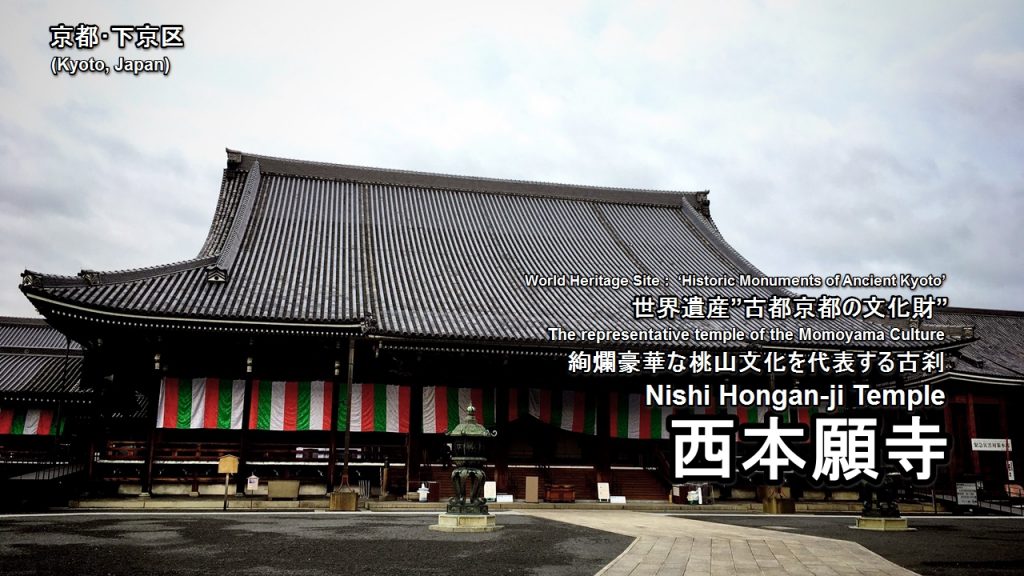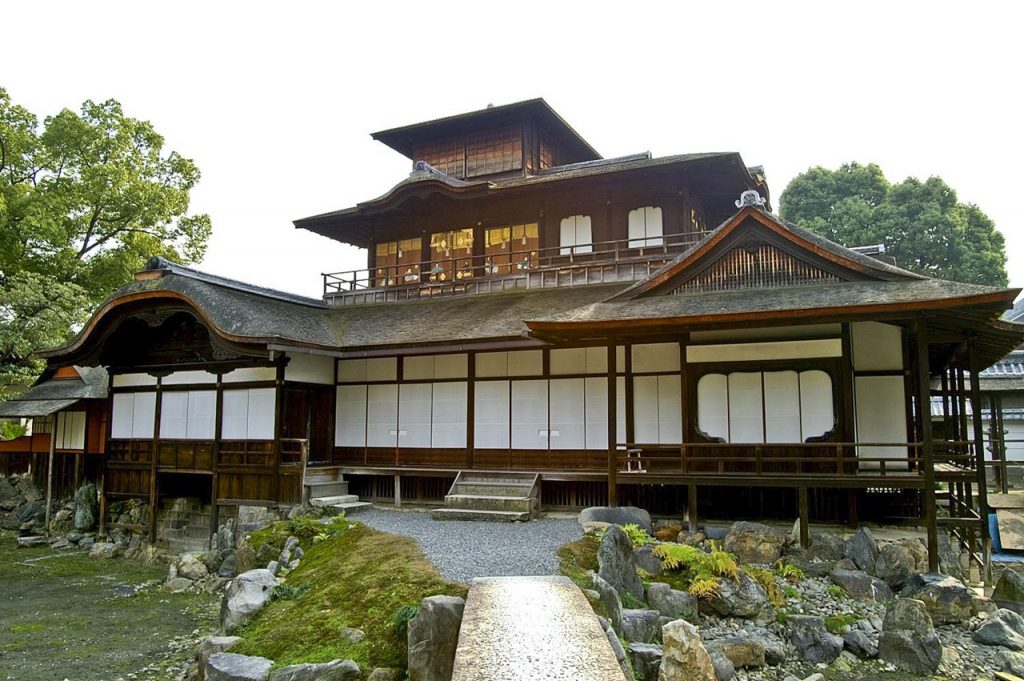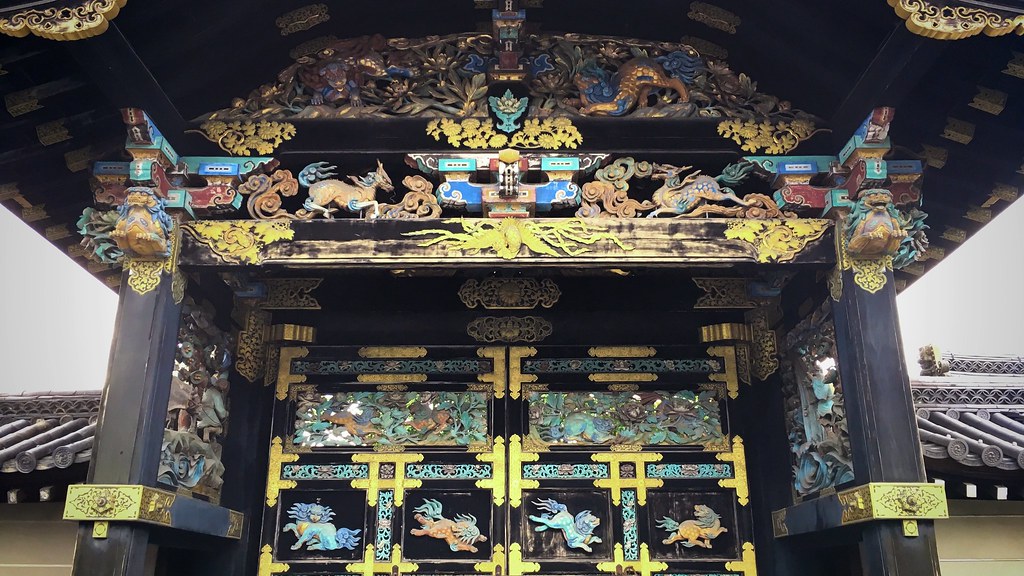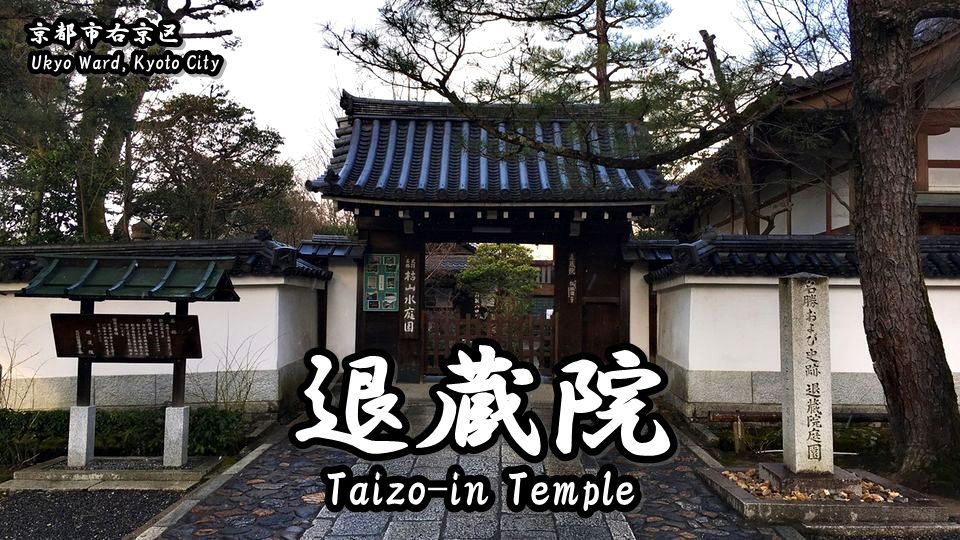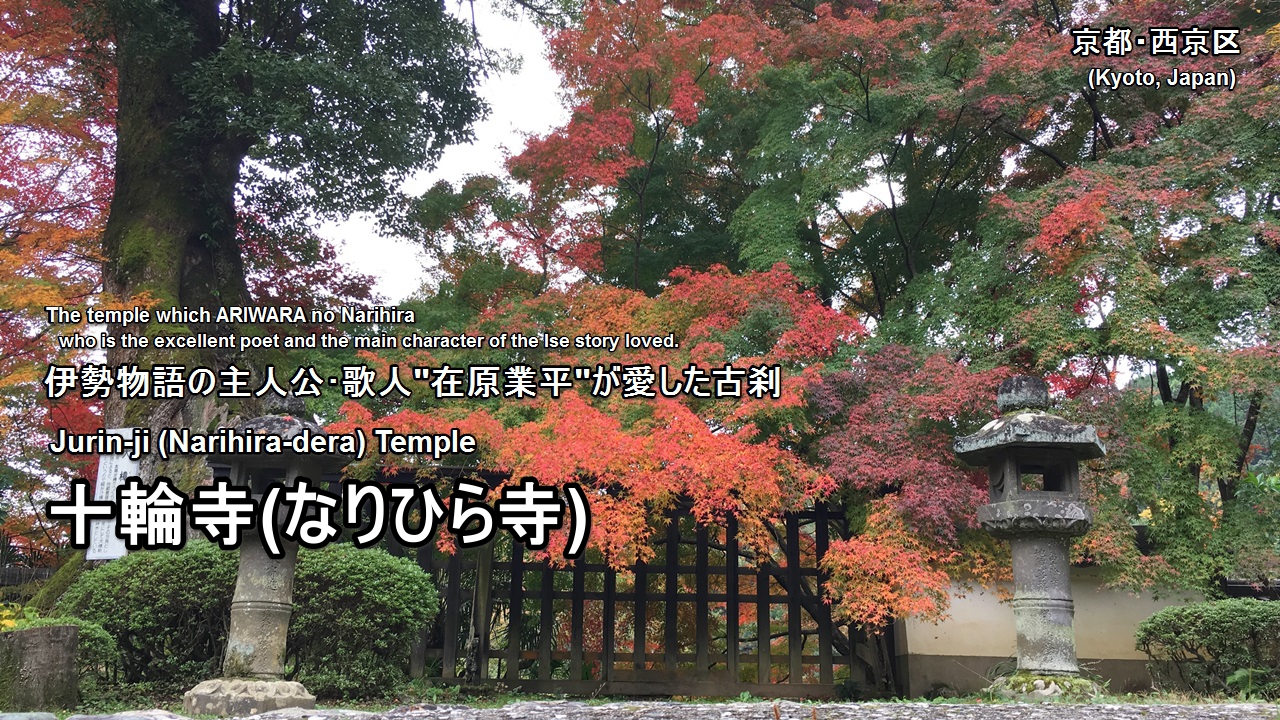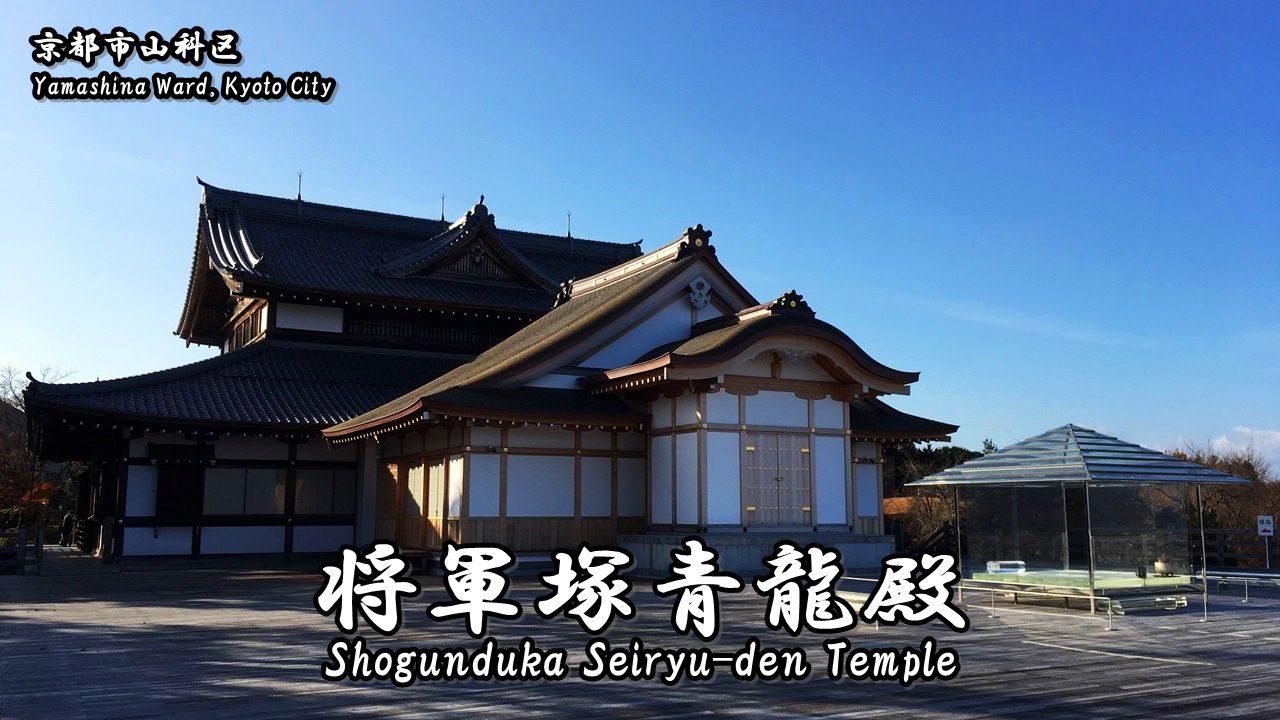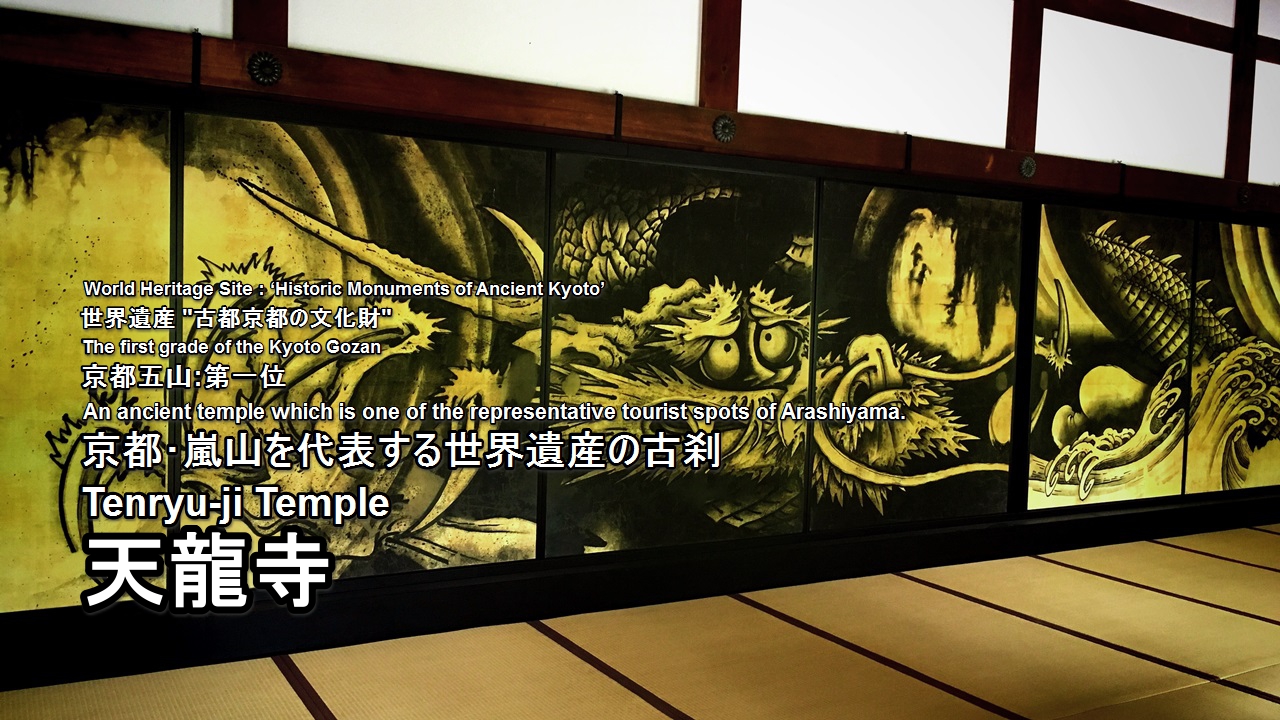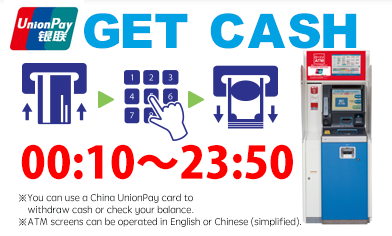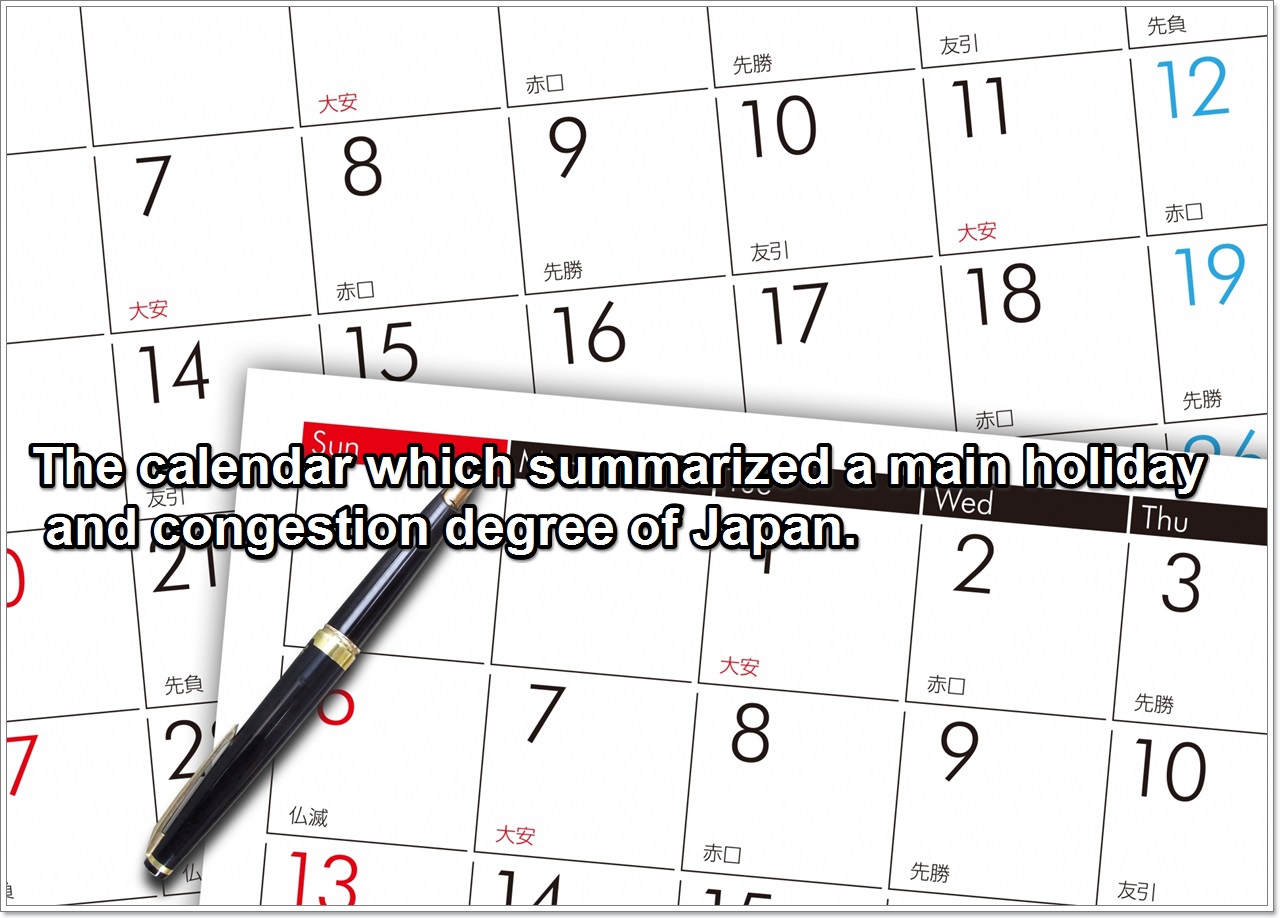Nishi Hongan-ji Temple is a head temple of the Hongan-ji branch of Jodo Shinshu located in Shimogyo-ku Ward, Kyoto City, Kyoto Prefecture.
This temple’s sango (mountain name) is ‘龍谷山(Ryukokuzan)’, and the formal name is ‘Ryukokuzan Hongan-ji Temple’.
Now, the Jodo Shinshu Sect of Buddhism has two big sects of the ‘Hongan-ji branch of Jodo Shinshu‘ and the ‘Otani branch of Jodo Shinshu‘.
Therefore two big temples of ‘Nishi Hongan-ji Temple’ and ‘Higashi Hongan-ji Temple‘ are in Kyoto now.
In order to distinguish it from the Otani branch of Jodo Shinshu (commonly called ‘Ohigashi-san’, or ‘Higashi Hongwan-ji Temple’), this temple is called ‘Onishi-san’, or ‘Nishi Hongan-ji Temple’.
In addition, this temple has been designated as the Michelin green guide ★ and the World Heritage List as part of the ‘Historic Monuments of Ancient Kyoto’.
Contents:
- About World Heritage ‘Historic Monuments of Ancient Kyoto’
- Why was the Hongan-ji Temple split into two temples?
- About Nishi Hongan-ji Temple
- Visitor Information
- Highlights of Nishi Hongan-ji Temple
- Photos of Nishi Hongan-ji Temple
- Goshuin of Nishi Hongan-ji Temple
- How to get to the Nishi Hongan-ji Temple
1.About World Heritage ‘Historic Monuments of Ancient Kyoto’
17 places of temples and shrines of Kyoto are designated in the ‘Historic Monuments of Ancient Kyoto’.
↓Details of the “Historic Monuments of Ancient Kyoto” is here.↓
Nishi Hongan-ji Temple has been designated as the World Heritage List as part of the ‘Historic Monuments of Ancient Kyoto’.
2.Why was the Hongan-ji Temple split into two temples?
Let’s study the Japanese history with me before introducing Nishi Hongan-ji Temple.
I think that we can enjoy the sightseeing of Hongan-ji Temple still more by learning the history of these temples.
Once upon a time in Japan…
Originally, the Nishi Hongan-ji Temple and the Higashi Hongan-ji Temple were one big temple of the Jodo Shinshu Sect of Buddhism.
In the Sengoku period, Hongan-ji was one of the major force in Japan.
So, they had resistance movement which was called ‘Ikko ikki‘ to resist Sengoku daimyo(feudal lord) in each place of Japan.
(From that time, the Hongan-ji Temple was also called ‘Ikko-Shu(Ikko Sect)‘.)
The Hongan-ji religious group of this period was an armed battle group to Sengoku daimyo definitely.
Particularly, the conflict between Hongan-ji Temple and the Oda clan, which began in 1570 and lasted over ten years as the so-called ‘Ishiyama Gassen(War)‘, burdened Nobunaga ODA heavily, since Hongan-ji Temple had gained the upper hand through the coalition between Kennyo and others who had entrenched themselves in the fortified Ishiyama Honganji Temple, and Hongan-ji Temple followers who carried on a resistance movement against the Oda clan in various regions.
But, finally, because Nobunaga ODA destroyed Ishiyama Honganji Temple which was the head temple of Hongan-ji religious group in 1580, the Hongan-ji’s power became weak.
By the way, it is also said that the series of Ikko Ikki is one of the reason that Nobunaga Oda was not able to unify Japan.
Later years (in the Edo period), it is said that Ieyasu TOKUGAWA, who had suffered from an uprising of Ikko sect followers in Mikawa in his youth, enticed Kyonyo who was a suzerain of Hongan-ji to separate Hongan-ji Temple to make the power of Hongan-ji Temple more diminish. (But there are different and various theories.)
Herewith, Hongan-ji Temple split into Nishi Hongan-ji Temple of which the twelfth monshu was Junnyo, the third son of Kennyo, (the present Hongan-ji branch of Jodo Shinshu) and Higashi Hongan-ji Temple of which the twelfth monshu was Kyonyo, the eldest son of Kennyo (the present Otani branch of Jodo Shinshu).
Then after the separation of Hongan-ji Temple, Higashi-Hongan-ji Temple and Nishii-Hongan-ji Temple came to confront each other, and resultantly, the sect gradually lost the strong armed religious power that had been threatened daimyo in the Sengoku period.
And, that situation is ongoing…
3.About Nishi Hongan-ji Temple
Nishi Hongan-ji (西本願寺 Nishi Hongan-ji) “Western Temple of the Original Vow” is one of two temple complexes of Jōdo Shinshū in Kyoto, Japan, the other being Higashi Honganji, or “Eastern Temple of the Original Vow”. Jōdo Shinshū is a school of Pure Land Buddhism, and today Nishi Hongan-ji serves as the head temple of the Jōdo Shinshū organization.As with many sites in Kyoto, they have more casual names, and are known affectionately in Kyoto as Onissan (お西さん, Dear Mr. West) and Ohigashisan (お東さん, Dear Mr. East).
引用(citation):https://en.wikipedia.org/wiki/Nishi_Honganji
Open:5:30-17:00(November – February), 5:30-17:30(March, April, September, October), 5:30-18:00(May – August)
Admission Fee:Free
Address:Horikawa-dōri Hanaya-chō Kudaru Honganji Monzen-machi, Shimogyō-ku, Kyoto, Kyoto Prefecture
Phone Number:+81-75‐371‐5181
Foundation:1591
Founder:Kennyo
Sect:Hongan-ji branch of Jodo Shinshu
Principal image:Amida Nyorai (Amitabha Tathagata)
Nishi Hongan-ji Temple is a head temple of the Hongan-ji branch of Jodo Shinshu located in Shimogyo-ku Ward, Kyoto City, Kyoto Prefecture.
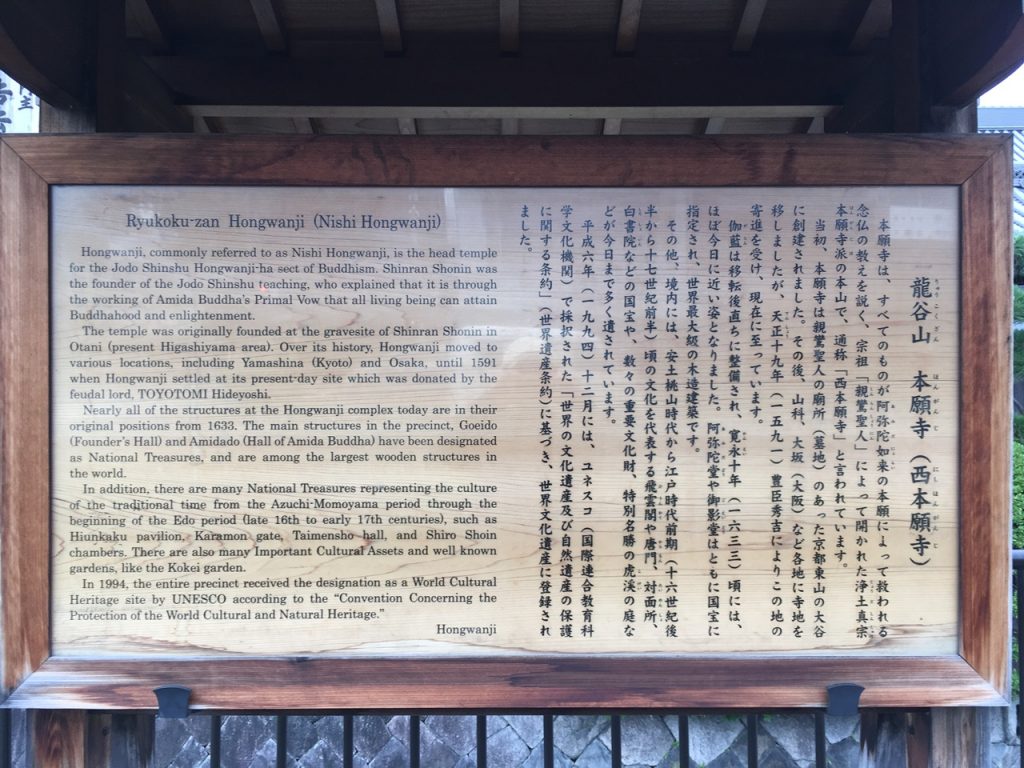
There is the Higashi Hongan-ji Temple which is the head temple of the Otani branch of Jodo Shinshu on the east side of the Nishi Hongan-ji Temple.
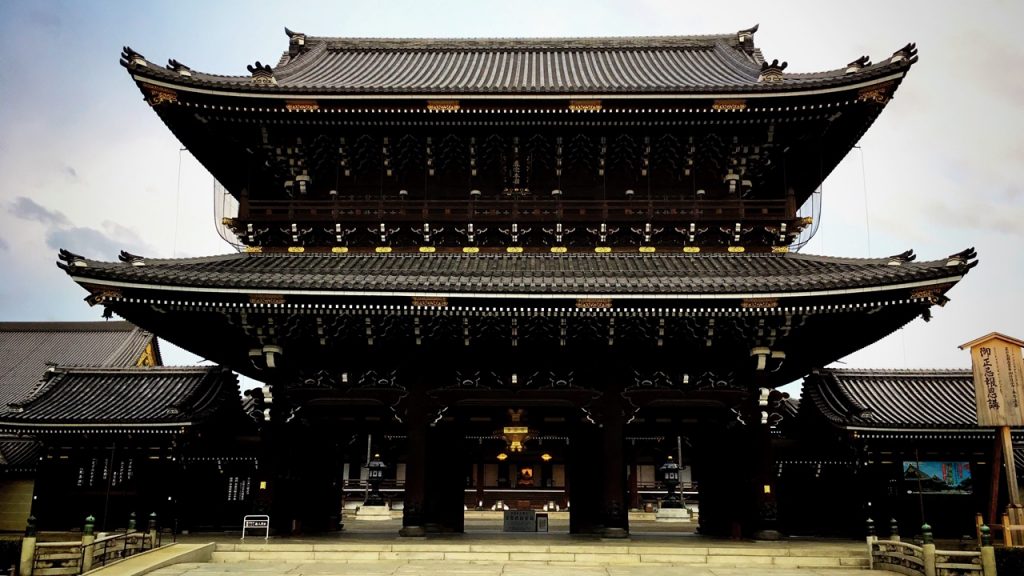
Goei-do hall and Amida-do hall of this temple are very big wooden buildings designated as a national treasure.
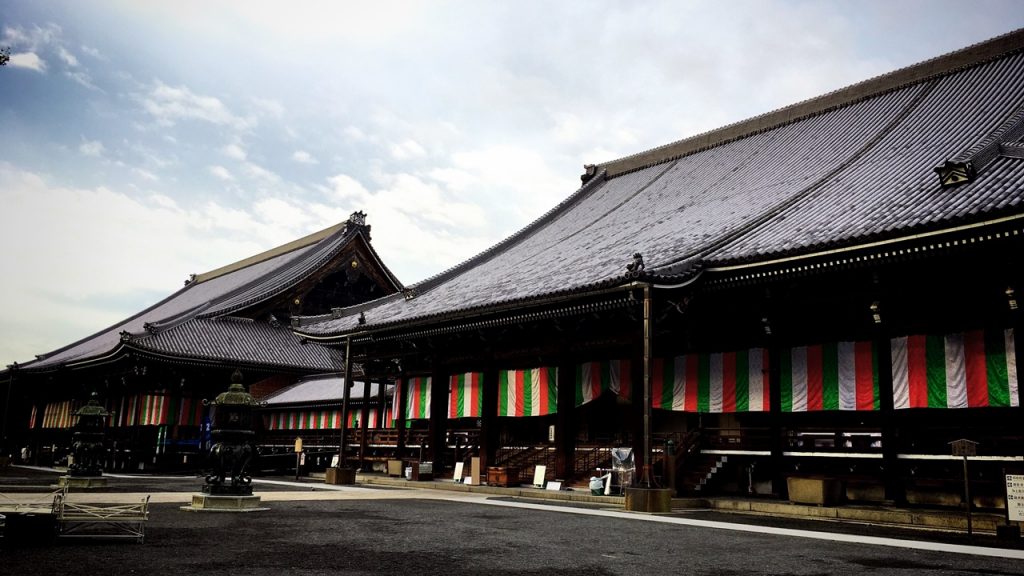
Namu Amida Butsu (南無阿弥陀仏) is a prayer to Buddha of the Buddhism of Jodo sect.
But, because Shinran pronounced ‘南無’ as ‘Namo,’ the Hongan-ji branch of Jodo Shinshu sect customarily calls it ‘Namo amidabutsu.’
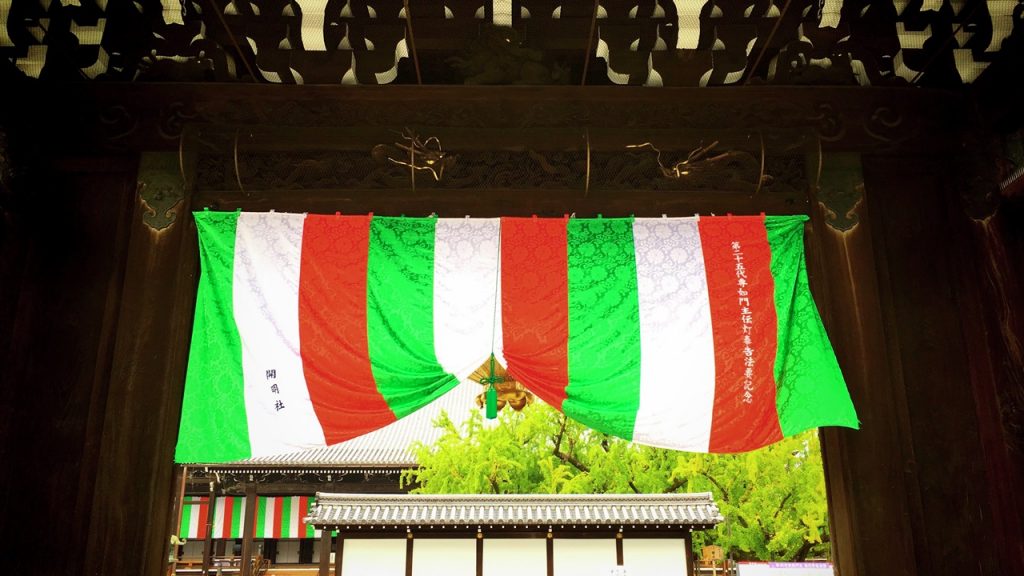
The temple crest of the Nishi Hongan-ji temple is Kujo-Sagari-Fuji (hanging wisteria).
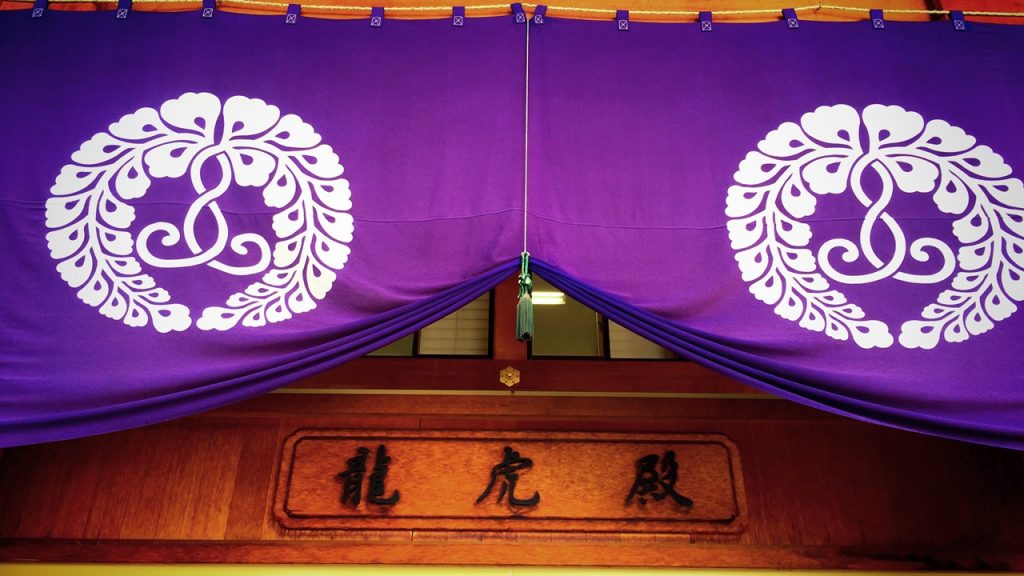
4.Visitor Information
・Shoin and Hiunkaku Pavilion are only open to the public on specific days.
(The reservation is necessary during other periods.)
■Specific periods
[2017]
March 7 – March 14
March 28 – April 4
April 11 – April 17
April 25 – May 2
May 9 – May 16
May 24 – May 31
■Open
9:00 -12:30, 15:30 – 17:00
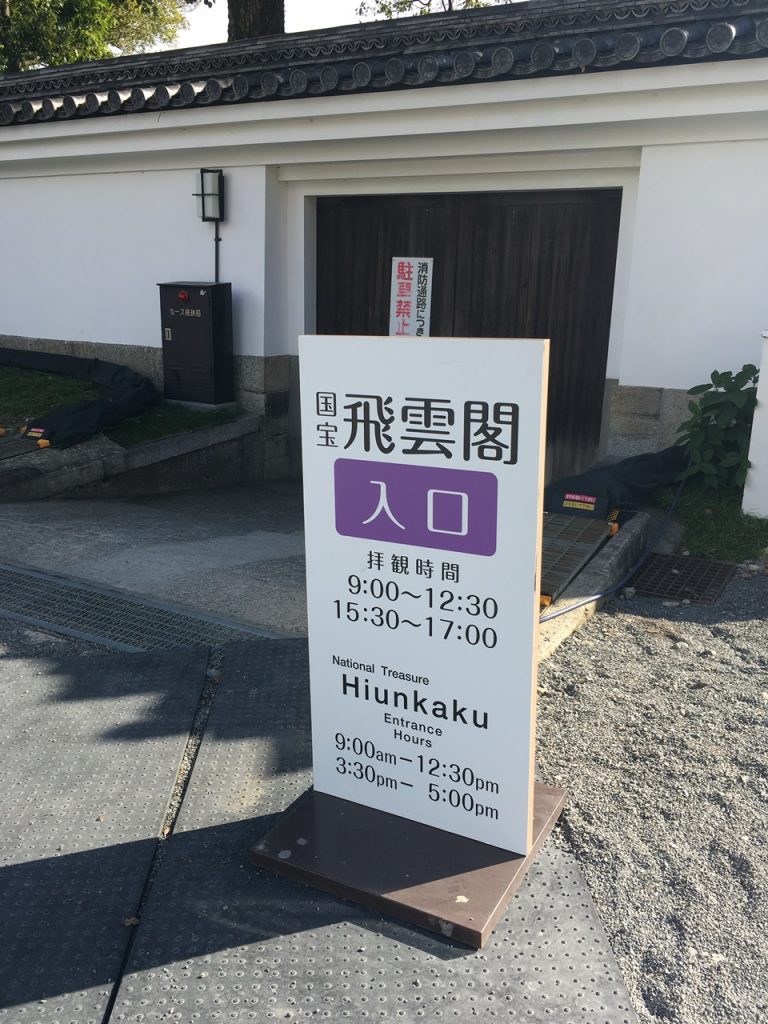
■Other periods
Reservation is requested by the previous day (reservation by phone is accepted).
Phone Number:+81-75-371-5181
Entrance time:10:30~ or 14:30~
We can make a reservation at a reception desk of the Ryuko-den hall.
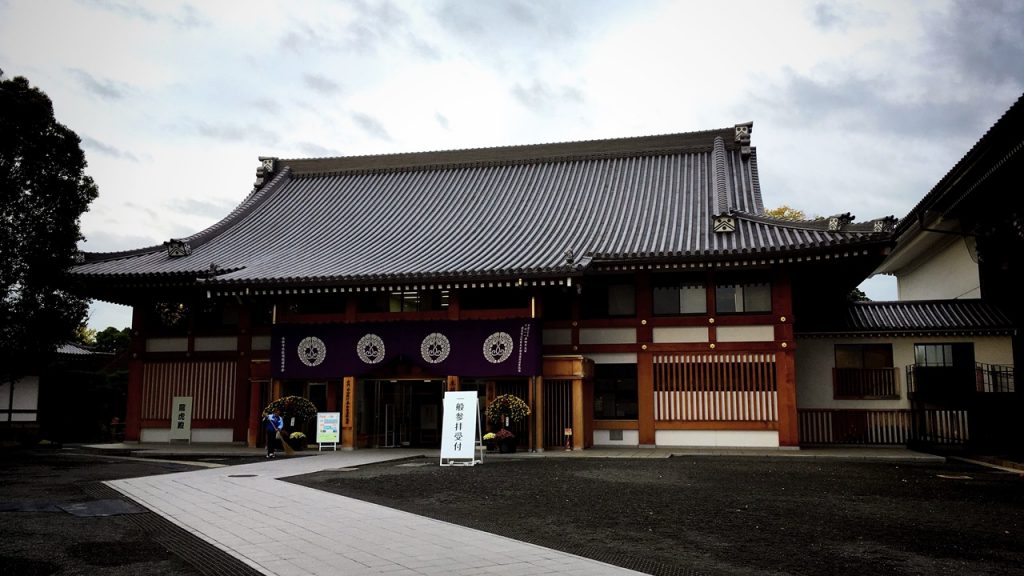
・Photography and video recording are prohibited inside the building of this temple and Hiunkaku Pavilion.
Let’s follow a rule.
5.Highlights of Nishi Hongan-ji Temple
- 御影堂門(重要文化財):Goeidomon gate(Important cultural property)
- 阿弥陀堂門(重要文化財):Amidadomon gate(Important cultural property)
- 御影堂(国宝):Goei-do hall(National treasure)
- 阿弥陀堂(国宝):Amida-do hall(National treasure)
- 経蔵(重要文化財):Kyozo (sutra repository)(Important cultural property)
- 龍虎殿:Ryuko-den
- 書院(国宝):Shoin (Study hall)(National treasure)
- 唐門(国宝):Kara-mon Gate(National treasure)
- 大玄関門:O-genkan gate
- 大玄関:O-genkan(Grand entrance)
- 飛雲閣(国宝):Hiunkaku Pavilion(National treasure)
- 鐘楼(重要文化財):Shoro (bell tower)(Important cultural property)
- 手水舎(重要文化財):Chozuya(Important cultural property)
- 大銀杏(天然記念物):Oicho(the big ginkgo tree)(Natural monument)
- 太鼓楼・御成門(重要文化財):Taiko-ro(Drum tower)・Onari-mon gate(Important cultural property)
- 築地塀(重要文化財):Roofed mud-wall(Important cultural property)
- 本願寺 おてらかふぇ&まるしぇ AKARI:HONGWANJI Otera cafee marche
●御影堂門(重要文化財):Goeidomon gate(Important cultural property)
This is the Goeidomon gate built in the Edo period which is designated as an Important cultural property.
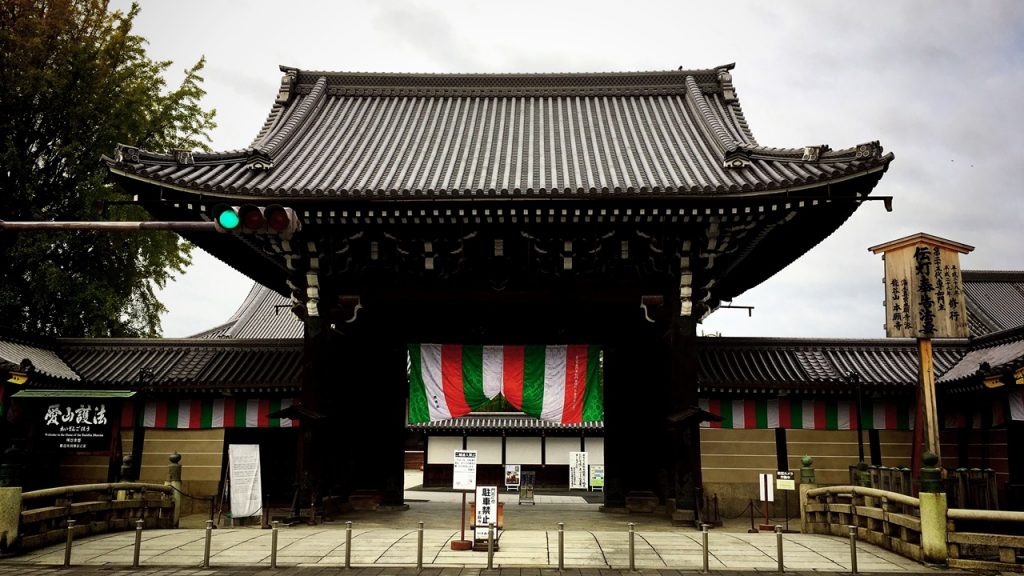
The roof of this gate is formal tile-roofing.
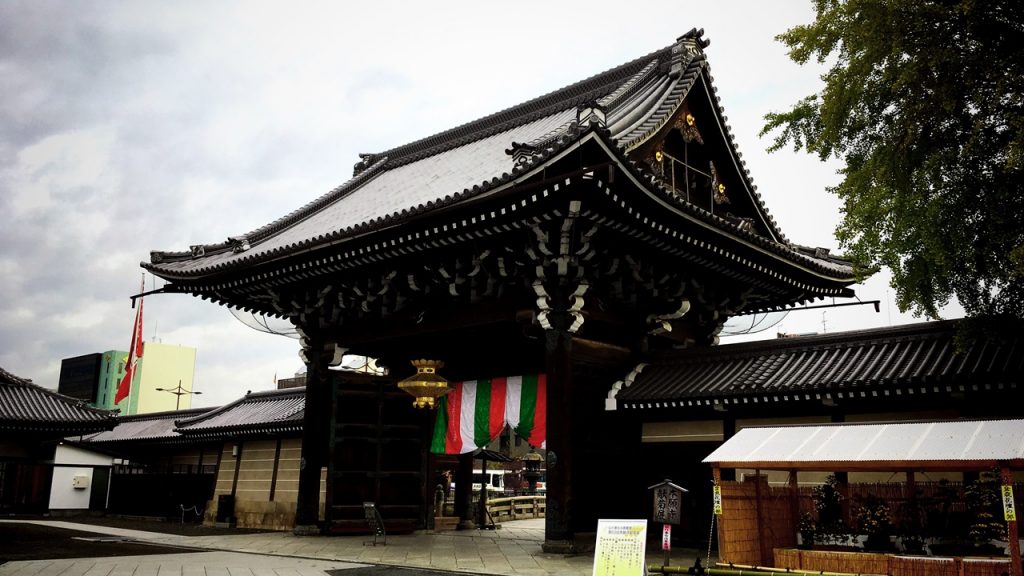
●阿弥陀堂門(重要文化財):Amidadomon gate(Important cultural property)
This is the Amidadomon gate built in the Edo period which is designated as an Important cultural property.
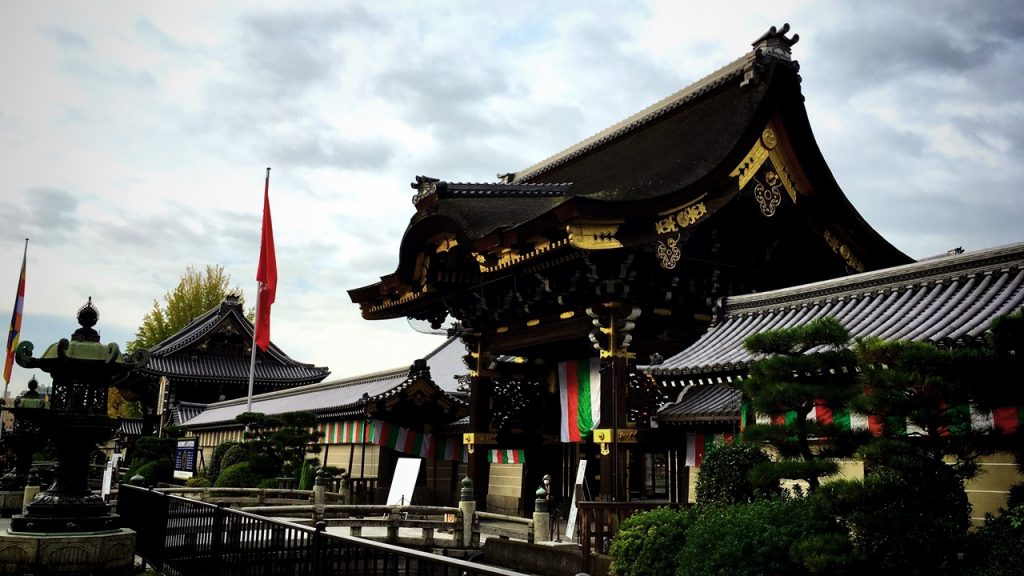
The roof of this gate is Hiwadabuki (roofs with the bark of hinoki, Japanese cypress).
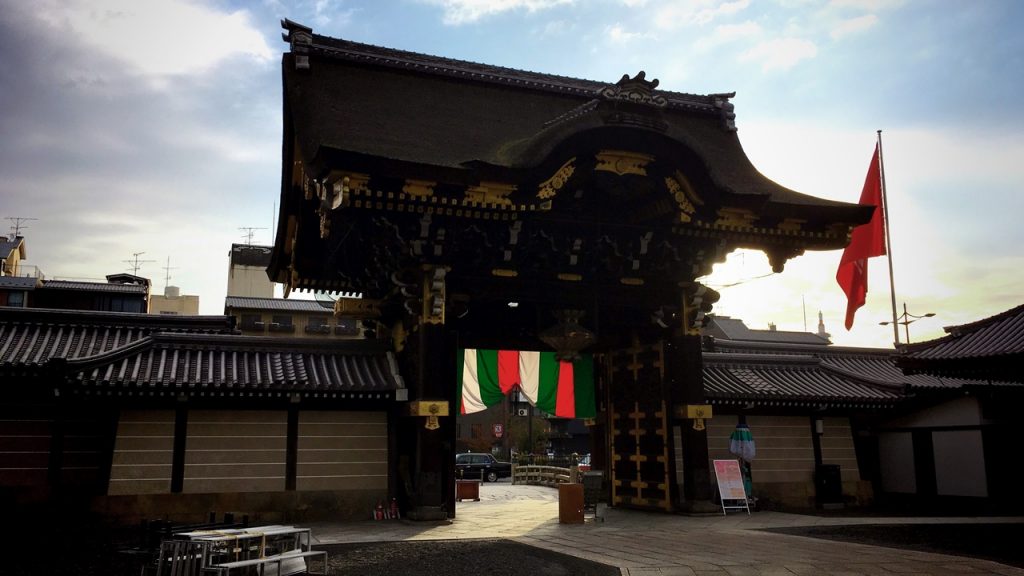
●御影堂(国宝):Goei-do hall(National treasure)
This is the Goei-do hall rebuilt in 1636 of the Edo period which is designated as a National treasure.
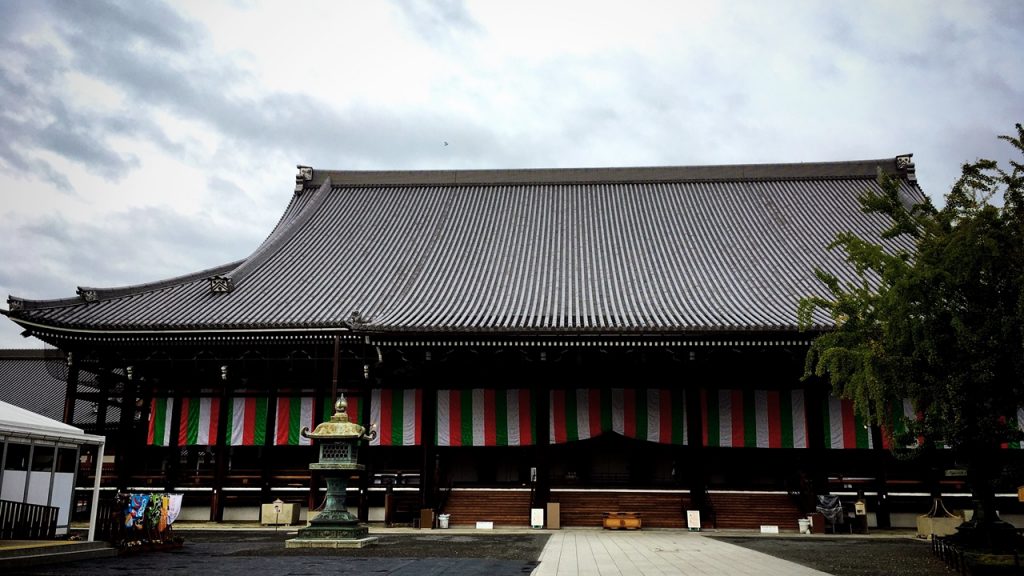
Shinran who was a sect founder of the Jodo Shinshu Sect is enshrined in this building.
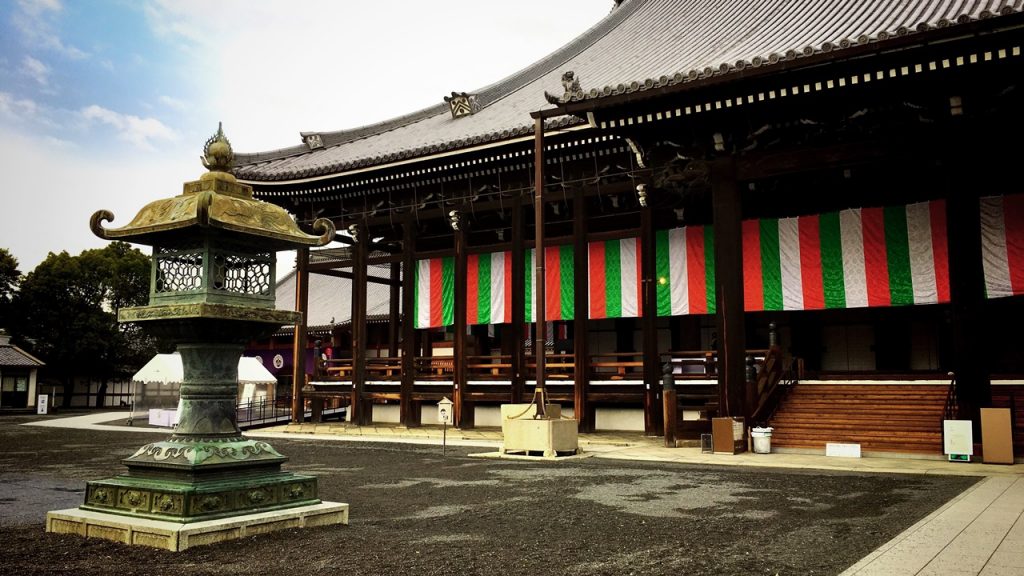
The rainwater-receiver of this building is supported by Amanojaku which is one of the ghosts of the Japanese ogre. (○´艸`)
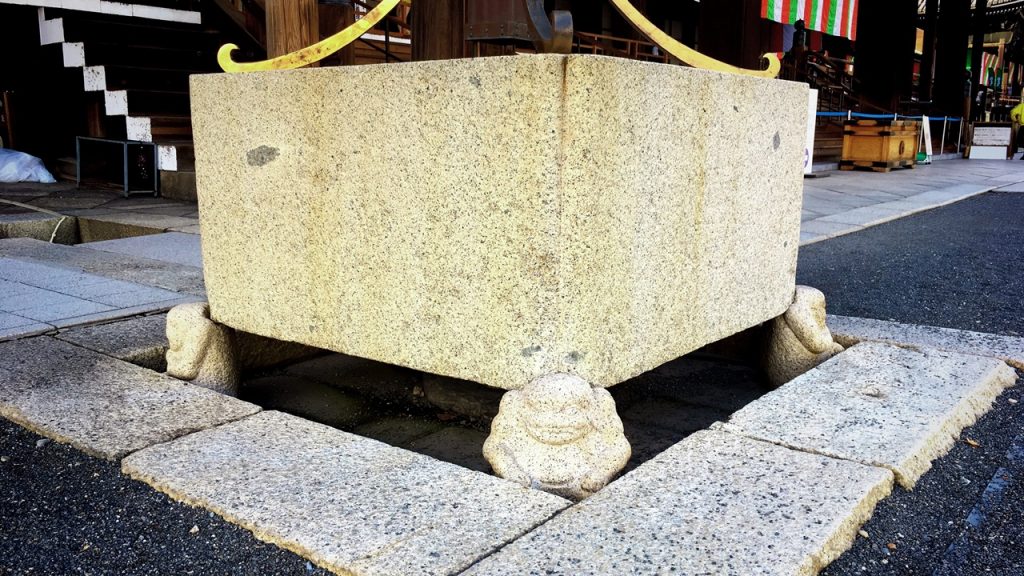
●阿弥陀堂(国宝):Amida-do hall(National treasure)
This is the Amida-do hall rebuilt in 1760 of the Edo period which is designated as a National treasure.
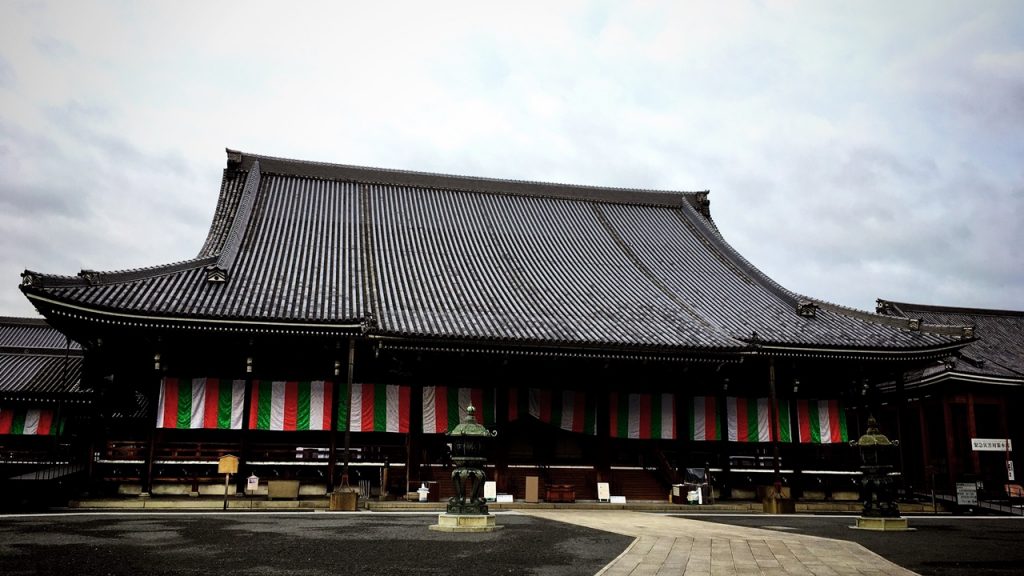
This building is the main hall of this temple, and Amida Nyorai (Amitabha Tathagata) which is the principal idol is enshrined in the building.
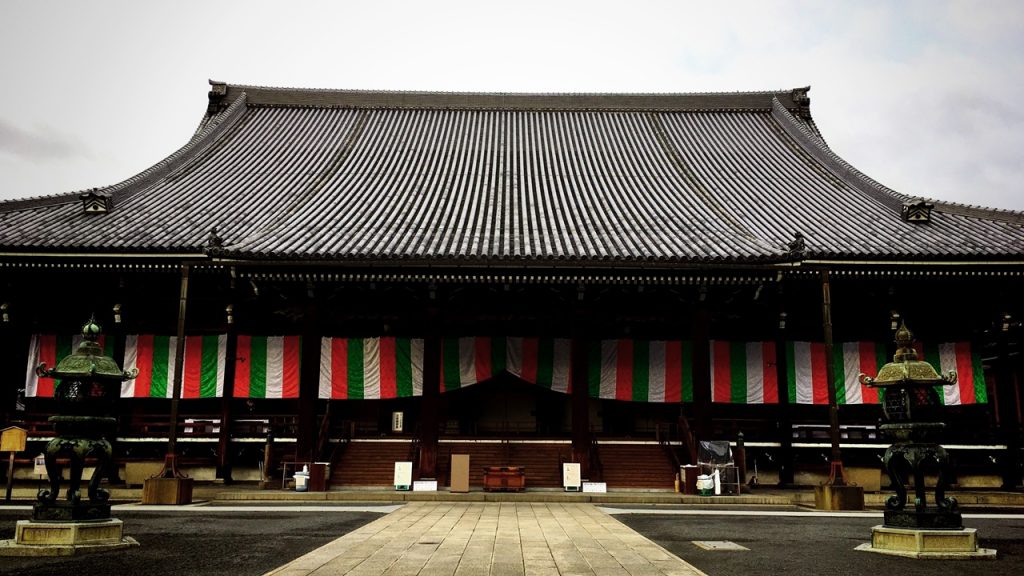
●経蔵(重要文化財):Kyozo (sutra repository)(Important cultural property)
This is the Kyozo (sutra repository) built in the Edo period which is designated as an Important cultural property.
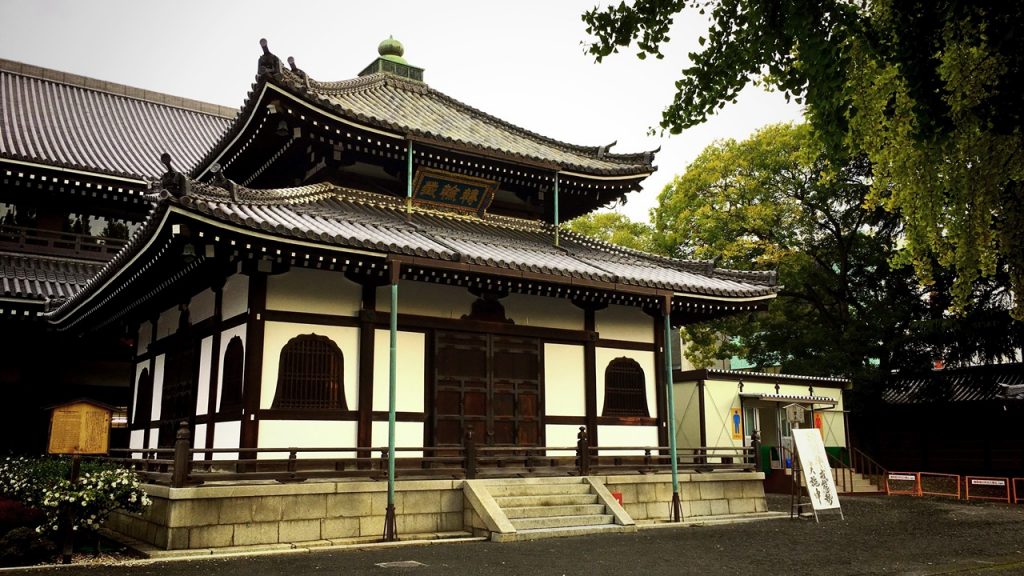
●龍虎殿:Ryuko-den
This is the Ryuko-den built in 2009.
Reception desk and reservation desk are in this building.
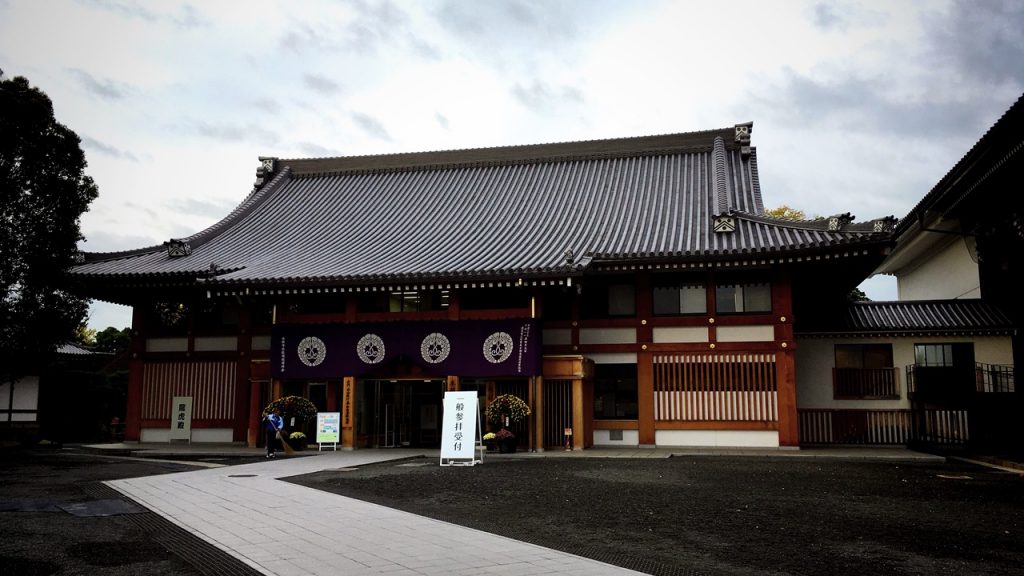
●書院(国宝):Shoin (Study hall)(National treasure)
This is the Shoin (Study hall) built in the Edo period which is designated as a National treasure.
A reservation is necessary to enter this building.
*Photography and video recording are prohibited inside this building.

This building is divided into O-Shoin, Shiro Shoin, Kuro Shoin and North and south Noh stage.
These buildings are all designated as a National treasure.

Particularly, the north noh stage in the Shiro Shoin is known as Japanese oldest noh stage.
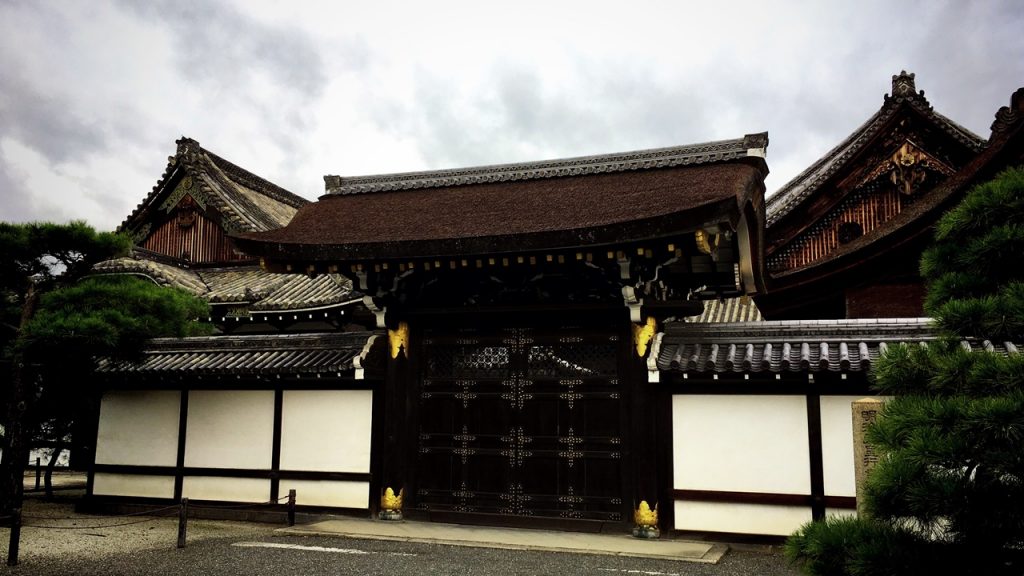
●唐門(国宝):Kara-mon Gate(National treasure)
This is the Kara-mon Gate built in the Edo period which is designated as a National treasure.
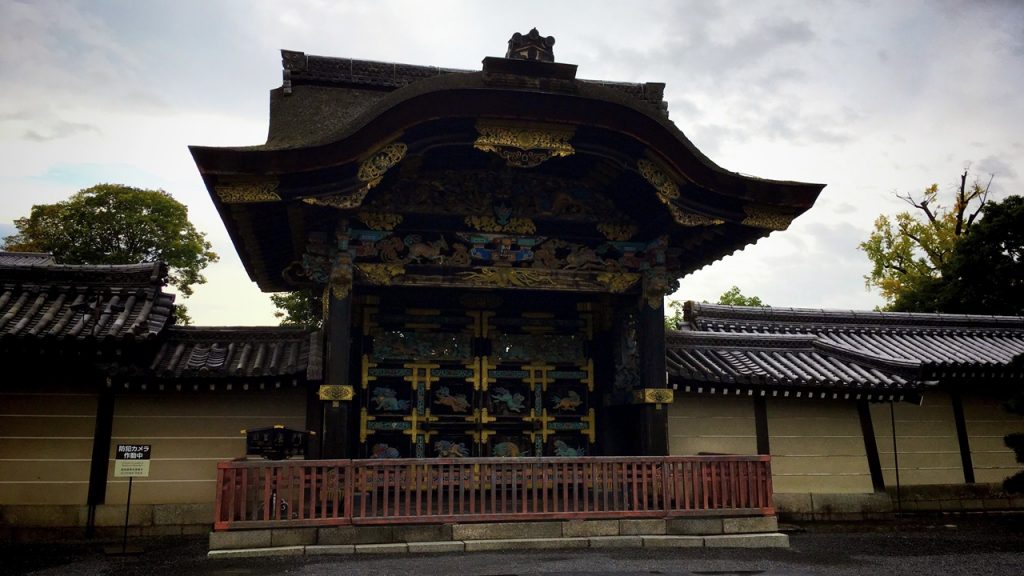
It is said that this luxurious decoration is affected by the Momoyama Culture.
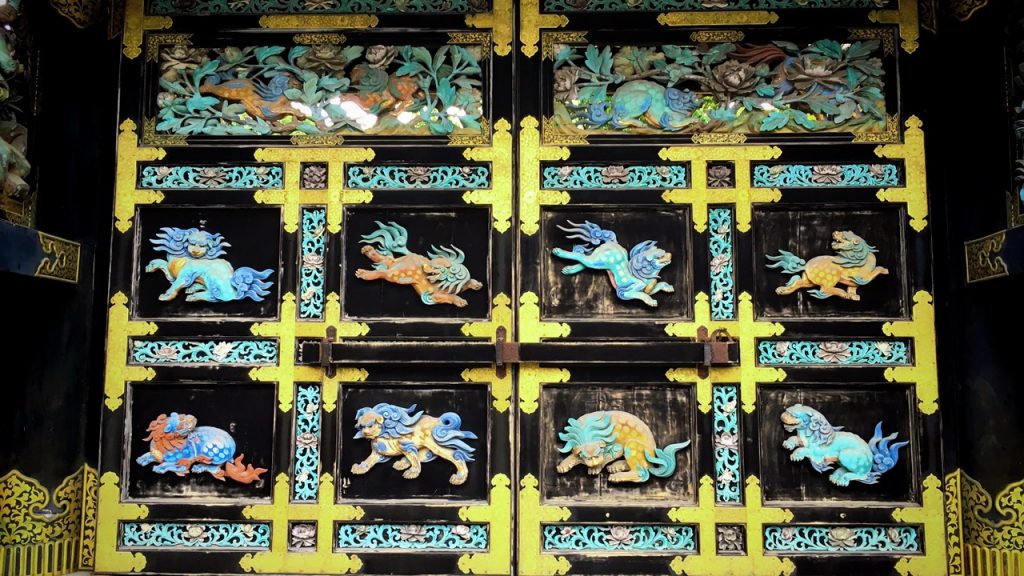
●大玄関門:O-genkan gate
This is the O-genkan gate built in 1847 of the Edo period.
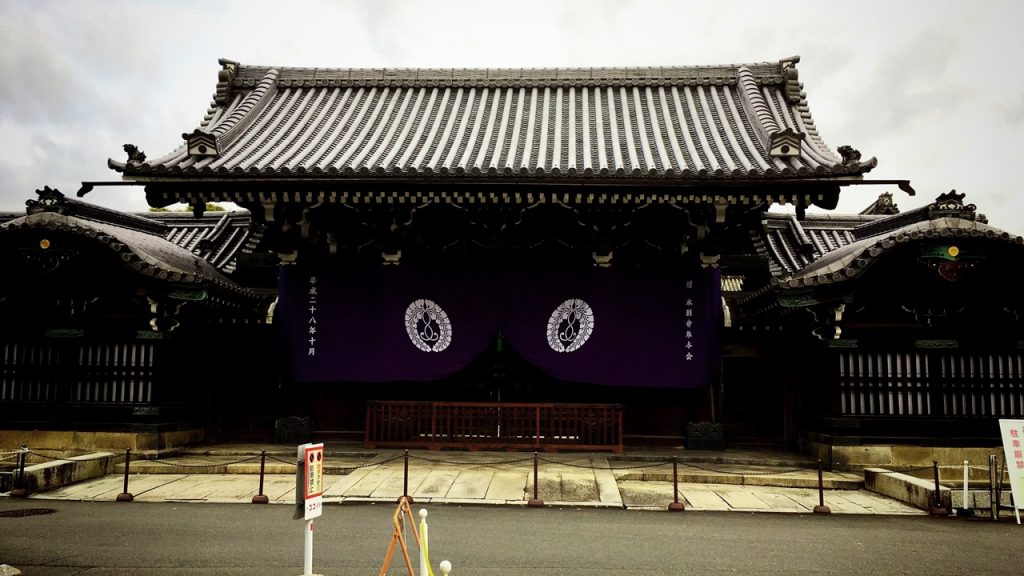
●大玄関:O-genkan(Grand entrance)
This is the O-genkan built in the Edo period which is the entrance of the Shoin.
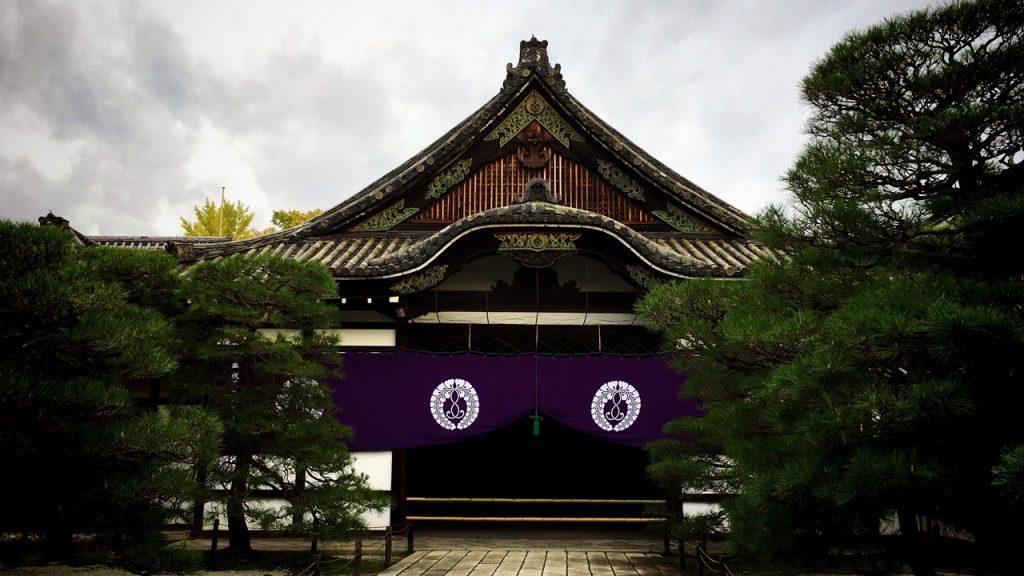
●飛雲閣(国宝):Hiunkaku Pavilion(National treasure)
This is the Hiunkaku Pavilion built in the Edo period which is designated as a National treasure.
Hiunkaku is one of “Kyoto’s three great pavilions” along with Shariden Hall of Kinkaku-ji Temple and Kannonden Hall of Ginkaku-ji Temple.
引用(citation):https://ja.wikipedia.org/wiki/%E8%A5%BF%E6%9C%AC%E9%A1%98%E5%AF%BA
●鐘楼(重要文化財):Shoro (bell tower)(Important cultural property)
This is the Shoro (bell tower) built in the Azuchi-momoyama period which is designated as an Important cultural property.
The same as Kara-mon gate, it is said that this luxurious decoration is affected by the Momoyama culture.
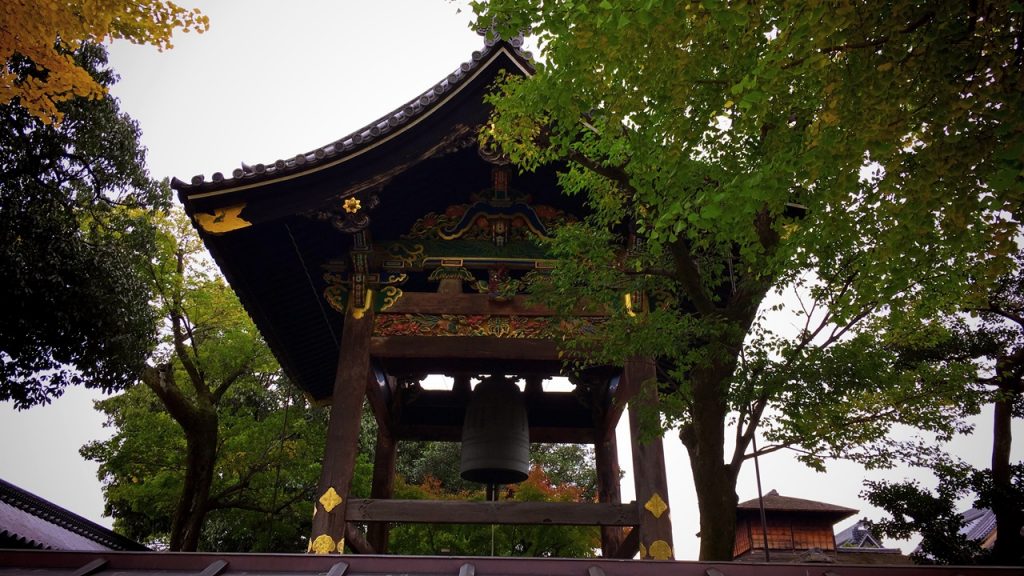
●手水舎(重要文化財):Chozuya(Important cultural property)
This is the Chozuya which was designated as an Important cultural property.
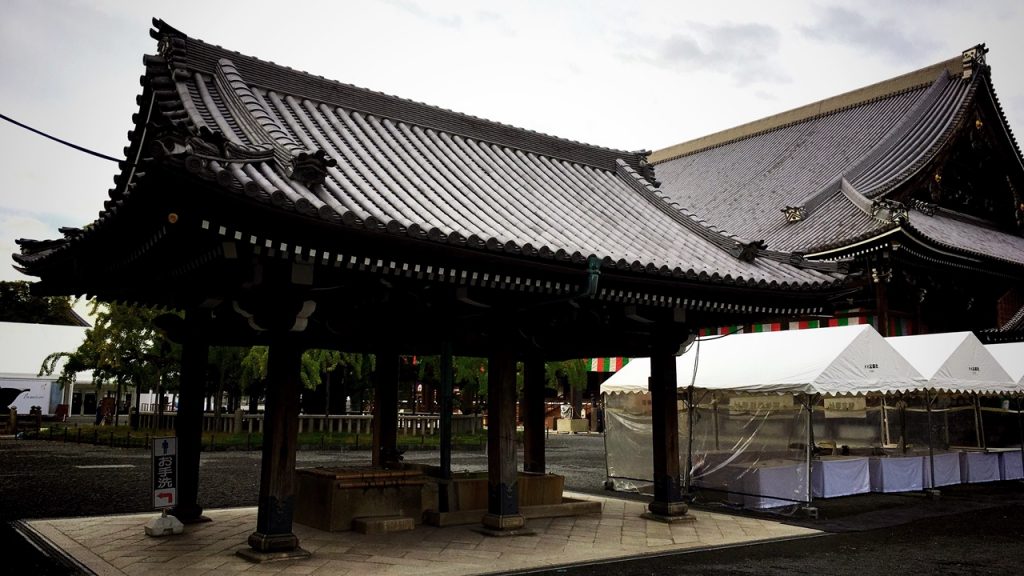
●大銀杏(天然記念物):Oicho(the big ginkgo tree)(Natural monument)
The big tree planted in the front of the Goei-do hall is Oicho (the big ginkgo tree) which is designated as a natural monument.
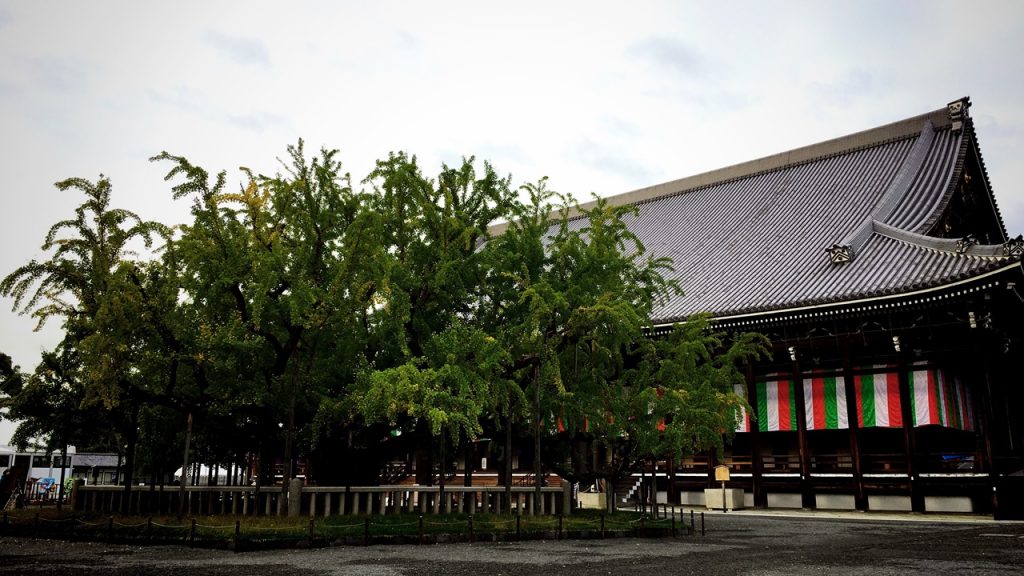
Because this tree’s trunk and branch are totally like the root, it is also called “reverse ginkgo tree”.
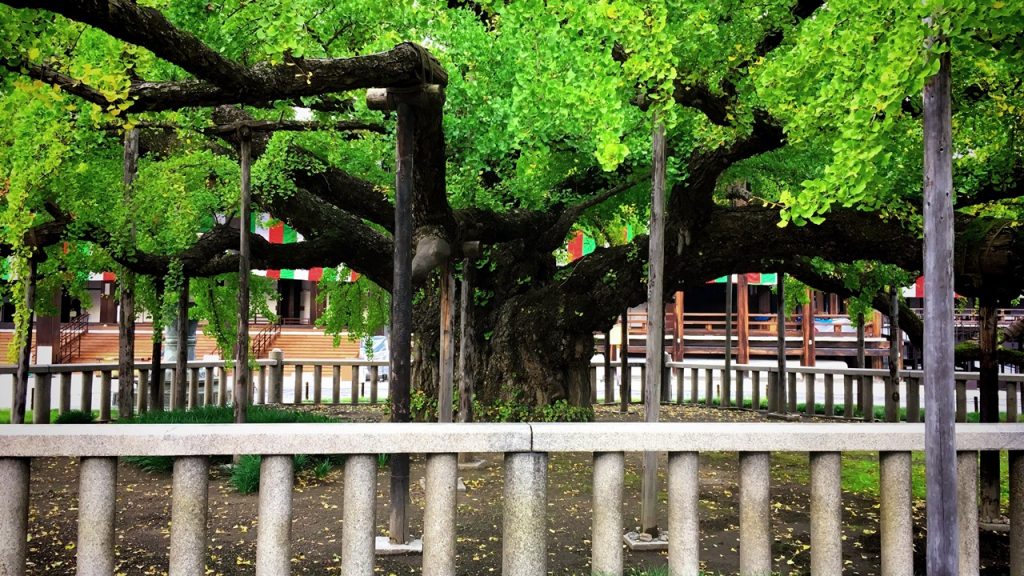
●太鼓楼・御成門(重要文化財):Taiko-ro(Drum tower)・Onari-mon gate(Important cultural property)
These are the Taiko-ro(Drum tower) and the Onari-mon gate built in the Edo period which are both designated as an Important cultural property.
The Taiko-ro(Drum tower) was a building which normally announced the time of gate openings at sunrise and sunset.
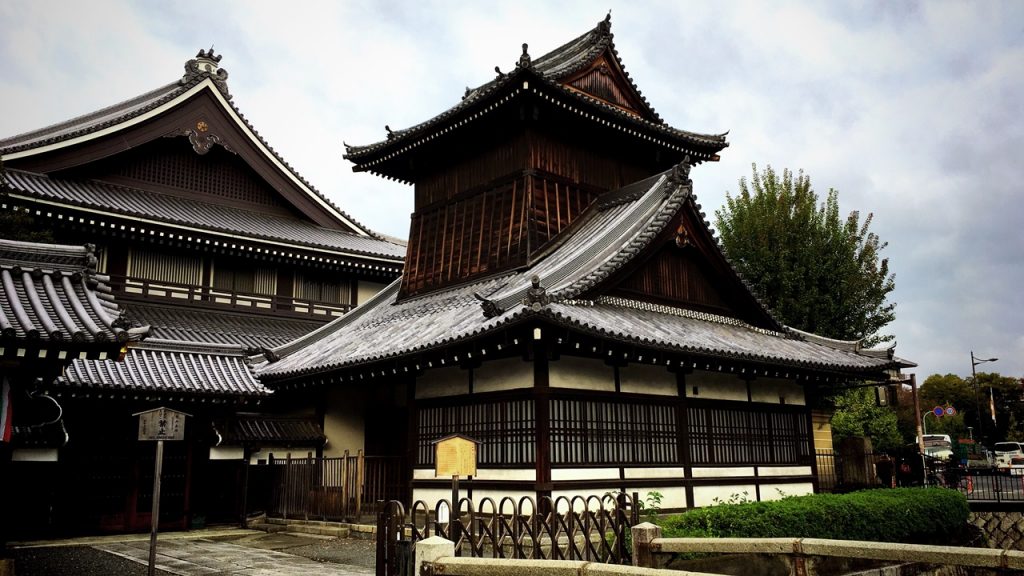
●築地塀(重要文化財):Roofed mud-wall(Important cultural property)
This is the Tsuijibei (Roofed mud-wall) built in the Edo period which is designated as an Important cultural property.
These walls are surrounding this temple.
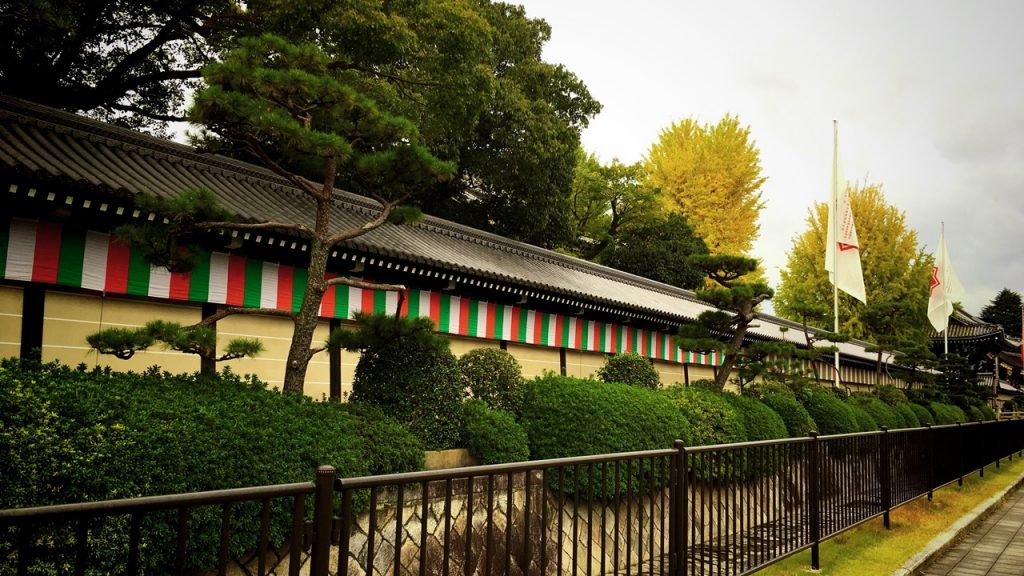
The white lines called Jogi-suji are drawn on this wall.
This white line expresses the grade of a Buddhist temple.
Five white lines are the best grade.
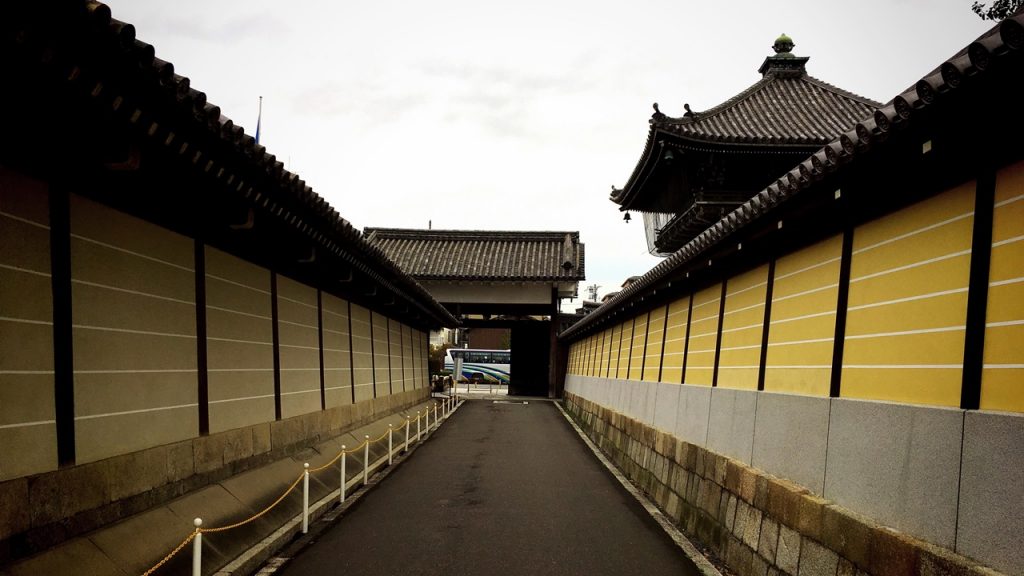
●本願寺 おてらかふぇ&まるしぇ AKARI:HONGWANJI Otera cafee marche
本願寺おてらかふぇ&まるしぇ AKARI
There is a time-limited cafe restaurant in the precincts of this temple.
The souvenir of Kyoto is sold here, too.

This cafe restaurant is open until May 31, 2017.
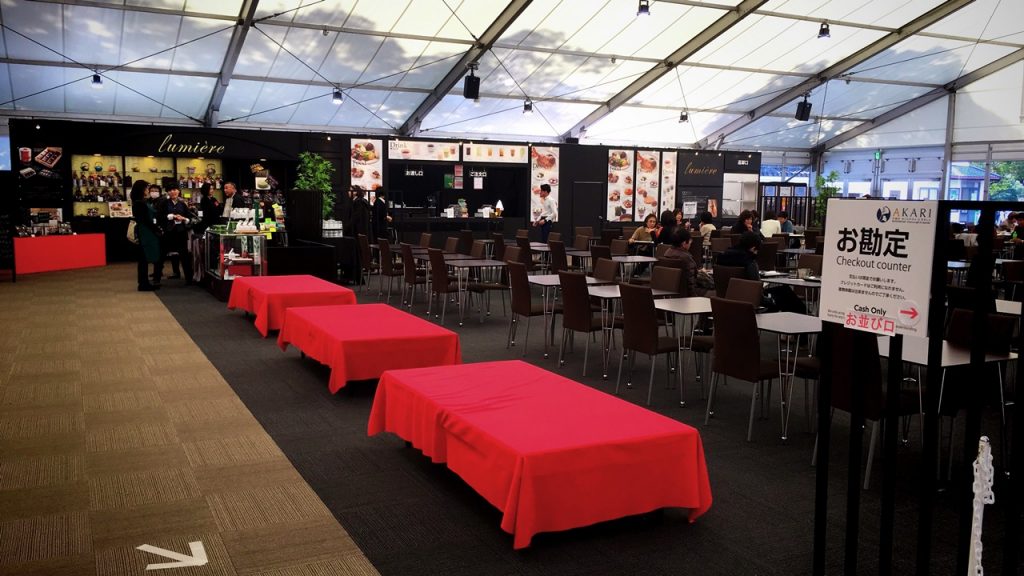
6.Photos of Nishi Hongan-ji Temple
■Flickr:Photo of Nishi Hongan-ji Temple (20161109)
7.Goshuin of Nishi Hongan-ji Temple
The Hongan-ji Temple does not have a goshuin.
But instead, we can get a commemorative seal at the Nishi Hongan-ji book center.

8.How to get to the Nishi Hongan-ji Temple
The nearest station of the Nishi Hongan-ji Temple is “JR Kyoto station”
(We can also go by bus from “Hankyu Kawaramachi Station”, “Keihan Gion-Shijo Station” and “JR Kyoto Station”.)
■Route Example (From Osaka station to Kyoto Station)

■Route Example (From Namba station to Kyoto Station)
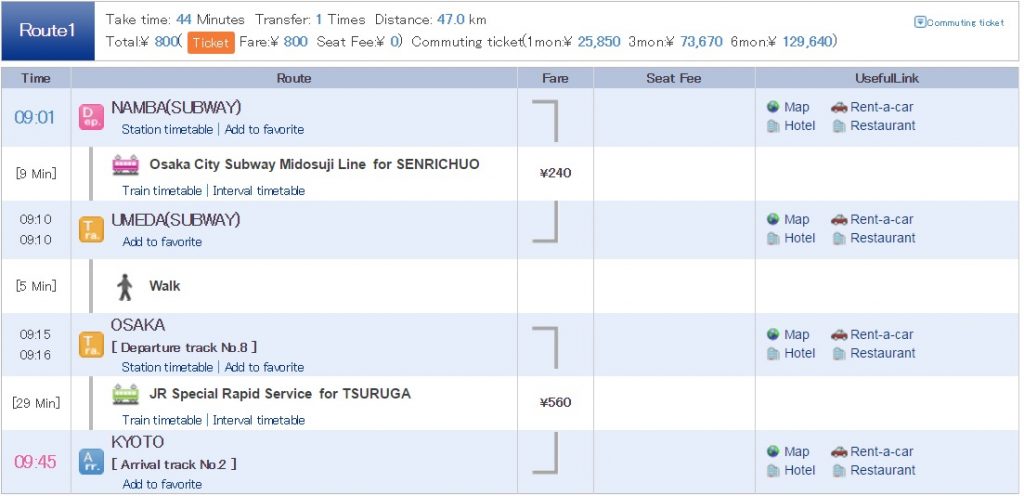
■Kyoto Station→Nishi Hongan-ji Temple
We go on foot from JR Kyoto Station to Nishi Hongan-ji Temple.
It’s about 20 minutes (1 km) on foot.
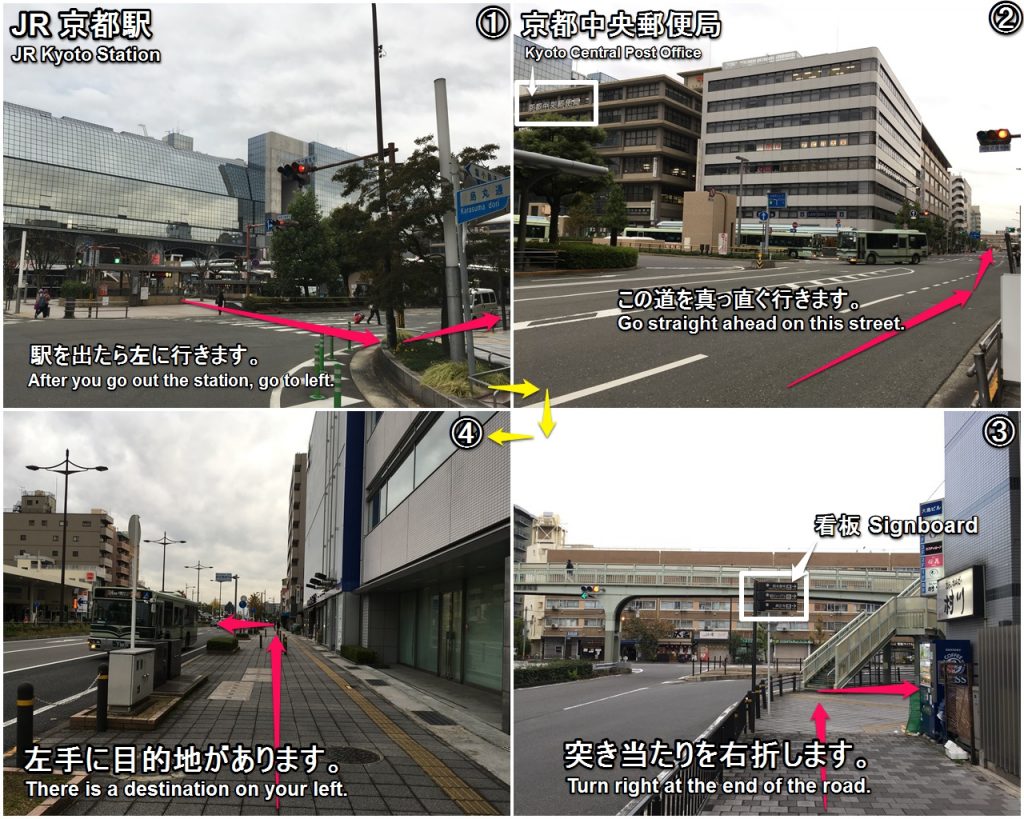
■When you get on a bus from JR Kyoto Station
Timetable and Route Search of bus
[Timetable]Route No.9
Bus company:Kyoto City Bus
Routes/Destination:No.9[Bound for Nishigamo Via Nijo-jo Castle]
Boarding bus stop:Kyoto Sta.[B1]
Alighting bus stop:Nishihonganji-mae (Nishihonganji Temple)
Bus fare:230 yen
Time required:About 6 min
[Timetable]Route No.28
Bus company:Kyoto City Bus
Routes/Destination:No.28[Bound for Daikakuji Temple Via Arashiyama]
Boarding bus stop:Kyoto Sta.[D3]
Alighting bus stop:Nishihonganji-mae (Nishihonganji Temple)
Bus fare:230 yen
Time required:About 6 min
[Timetable]Route No.75
Bus company:Kyoto City Bus
Routes/Destination:No.75[Bound for Eigamura]
Boarding bus stop:Kyoto Sta.[C5]
Alighting bus stop:Nishihonganji-mae (Nishihonganji Temple)
Bus fare:230 yen
Time required:About 6 min
■When you get on a bus from Hankyu Kawaramachi Station
Timetable and Route Search of bus
[Timetable]Route No.207
Bus company:Kyoto City Bus
Routes/Destination:No.207[Bound for Toji Temple Via Shijo Omiya]
Boarding bus stop:Shijo Kawaramachi[D]
Alighting bus stop:Shimabara-guchi
Bus fare:230 yen
Time required:About 20 min
■When you get on a bus from Keihan Gion-Shijo Station
Timetable and Route Search of bus
[Timetable]Route No.207
Bus company:Kyoto City Bus
Routes/Destination:No.207[Bound for Toji Temple Via Shijo Omiya]
Boarding bus stop:Shijo Keihan-mae[B]
Alighting bus stop:Shimabara-guchi
Bus fare:230 yen
Time required:About 25 min
■When you take a taxi
Let’s show a taxi driver the following phrase.
From Kyoto Station:About 5 minutes / 620 yen
From Gion-Shijo Station:About 15 minutes / 1,260 yen
How did you like it?
Please try to go.
Have a nice trip! XD
<Let’s search the sightseeing information of Kansai in Japan on ‘Japan’s Travel Manual‘!!>
<This site introduces the easiest way to get Japanese (Kansai) sightseeing spots to you.>

